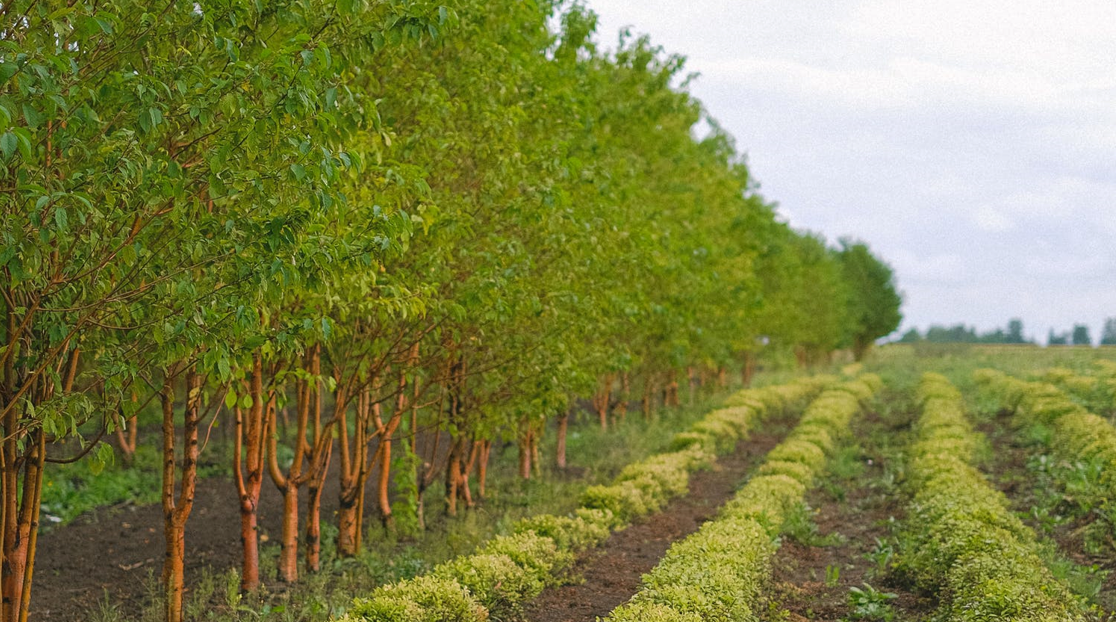Agroforestry – combining trees and agriculture to improve Soil – Water Conservation

This post is also available in:
This post is also available in:
![]() Français (French)
Français (French) ![]() Deutsch (German)
Deutsch (German) ![]() हिन्दी (Hindi)
हिन्दी (Hindi) ![]() العربية (Arabic)
العربية (Arabic) ![]() Türkçe (Turkish)
Türkçe (Turkish) ![]() 简体中文 (Chinese (Simplified))
简体中文 (Chinese (Simplified)) ![]() Português (Portuguese (Brazil))
Português (Portuguese (Brazil))
Cover picture: Shelter belt as windbreak. This is one form of agroforestry where interactions of trees or shrubs and crops are used.
Agroforestry does not necessarily mean that the field must look like a forest or forest garden.
It can be predominantly agricultural systems with hedges, scattered trees, or many trees along boundaries and buildings. For soil conservation, however, it is important that at least the belts across the slope are covered near the surface – particularly under trees.
Agroforestry can be fruit, nuts, and multipurpose trees established in forests. It can be forest gardens established jointly. It can be establishing, weeding, and protecting young forests or plantations among crops during the first years. It can e.g. also be a tree- or shrub fallows that can be combined with growing crops in the first season(s). Pastures with trees are agroforestry too. Areas available for natural forests are decreasing.
A natural forest is usually effective in covering the soil surface, conserving soil, and letting the water reach the ground to penetrate it. However, tall trees over bare soil surfaces can increase rainfall’s drop size and energy and consequently erosion.
With cover near the surface, agroforestry can help with soil conservation and water infiltration by:
- Adding value and organic matter like leaves to contour strips, terrace edges, and field boundaries with permanent vegetation near the surface like grasses, herbs, and low shrubs.
- Hedges seeded with close with-in line distance of, e.g., 10 cm and catch twigs and leaves on the surface, so run-off water is slowed down and enters well. Hedges with, e.g., 50-cm spacing and intensive weeding are much less effective if weeded much.
As trimmed hedges, nitrogen-fixing tree-legume can shed protein-rich leaves, promoting biological activity below them and shade near the surface. Hence, water rapidly infiltrates, causing sedimentation and terrace formation. E.g., leaves from the species Calliandra calothyrsus can cover the soil for some weeks and gradually releases their nitrogen due to their content of protein-binding polyphenols. These are also called tannins and can make the tongue stick lightly to the mouth when chewing a leaf. Leaf fibres can also increase durability (crush dried leaves to test). In western Kenya, I could push my finger 8 cm into the soil under such hedges direct seeded by farmers and terraces formed over a few years.
In contrast, they had no apparent effect where the soil surface below them was kept clear (e.g., at the international agroforestry research headquarters in Nairobi). About 50% erosion reduction in the first years is typical in studies in the tropics without reported attention to the undergrowth and transplanted with about 50-cm distance. With standard guidelines, establishing enough is challenging for farmers (Mandal (2010). See Figure 1.

Figure 1. Multipurpose hedge from the legume plant family. Hedge of the nitrogen-fixing, multipurpose, fodder-tree Calliandra calothyrsus with soil-protecting undergrowth stabilizing slope with leaves near the soil surface, falling leaves, roots, nutrient enrichment, and adding value to areas not cultivated (tilled). Tall trees on farms can also be a challenge because of rain drops joining at them fall with more erosive energy per square meter if the soil surface is not covered like e.g. in a natural forest. Their weight and wind movement can be a problem on steep slopes, but roots may stabilise the soil. Photo by T Mandal 2019, Kitale Kenya at Vi Agroforestry.
- Woody roots of shrubs and small trees can stabilize the build-up of terraces, but roots alone can concentrate and speed up some water flows.
- Contour hedges, tree lines, etc., can force hired ox- or tractor ploughmen to drive responsibly across the slope. All hedges do not have to reach field edges, so turning can be possible.
- Trees and shrubs can provide fuel, wood, and sometimes nutritious fodder. This reduces the need to burn crop residues because wood can be used as fuel and because crop residues can be enriched with green tree leaves and made useful. Used alone, e.g., maize stalks are too low, mainly in protein or nitrogen, to be good for fodder or soil fertility. Mixing with protein-rich tree leaves and twigs can help. Particularly tree legumes (from the bean or pea family) are rich in proteins and can usually fix nitrogen from soil air.
- More nutrients can improve plant cover and organic matter content, as mentioned. Nitrogen-fixing trees can better use slow-release phosphate sources like ash or most rock phosphate. Seasonal crops need relatively high levels of directly biological available phosphate when their root length still is low, and it has not been fully extended by symbiotic fungi (mycorrhiza) that are common in soils with plant residues. Trees and shrubs can also take up nutrients, e.g., N and K, from deep layers of soils where they have been washed down (leached) or where a deep layer of topsoil is deposited by sedimentation under hedges.
- Agroforestry trees and shrubs can add value to untilled contour belts, terrace edges, cut-off drains, gully control, fences, pastures, riverbanks, and protected areas. Nitrogen-fixing trees and shrubs can be good and valuable pioneer plants to start with – if using suitable methods and species. Many high-forest and fruit species are hard, to begin with, on open infertile land. Simply fencing off and prohibiting the use of an area for many years can be expensive and a challenge to get accepted. Local agreements may be made and may be respected in average years if the local benefit will be important and come early. Just waiting for vegetation’s “natural” re-establishment can give variable results. In the most degraded, overgrazed, and eroded areas, only the least valuable species may have survived, as well as hard seeds, and viable roots and stems may be found. Rainforest trees and fruit tree seeds usually only survive a few weeks and die if they dry out. Such seeds are called recalcitrant in contrast to orthodox seeds. They may also depend on specialized animals for pollination and seed spreading. Without a minimal and steady nutrient supply on degraded land, it can be slow and costly to establish even the hardiest grasses poorly suited for grazing animals (like often used Vetiver species). Agroforestry with, e.g., fruit or fodder trees, is essential to add value to contour stripes with permanent protective vegetation including terrasse edges and important for farmers to use land on them, e.g., in Kenya.
- Shelter belts and windbreaks of trees can reduce erosive windspeeds about 30-40 times further away than the height of a suitable shelterbelt. It is most effective when it is medium dense, e.g., 30%-70% open to looking through in temperate areas.
- Wildfire degrades and erodes landscape. Agroforestry can sometimes be used for green firebreaks using species that: are competing with flammable types, are adding nutrients so wilted, flammable materials can rot, and are staying green and moist in hot, dry seasons, and/or are reducing wind speeds. They do not let fire move up from the grass to the top (perhaps you to leaf-eating animals) or let burning parts fly far.
- Covering on or near the soil surface is essential for water erosion conservation. Agroforestry trees can add value to grass, herb, and dead plant litter covered below trees. However, trees over intensively tilled soil and no leaves near the ground can increase erosion because raindrops join on the leaves and fall with more energy per unit of the area after accelerating about 0.5 m or more.
Some rainwater will evaporate directly from the surfaces of the tree or slowly run down along the stem. However, concentrated flow from stems may start rill erosion, and sometimes soil shaded by trees is bare on slopes. In contrast, e.g., a mosquito net tested at 20-cm height stopped erosion.
Challenges mainly with Eucalyptus (or sometimes pine) have unfortunately given all “exotic” trees a bad reputation. Likewise, the tree legume Leucaena leucocephala was promoted as a miracle tree. Still, in 1990, its new shoots were severely hit by Leucaena leafhoppers spreading to the world before natural enemies multiplied locally.
References
Baumhardt RL, and Blanco-Canqui H 2014 Soil: Conservation Practices. In: Neal Van Alfen, editor-in-chief. Encyclopedia of Agriculture and Food Systems 5, Elsevier, 153-165.
Hudson W N 1987 Soil and water conservation in semi-arid areas. Silsoe Associates Ampthill, Bedford United Kingdom. Soil Resources, Management and Conservation Service. FAO Land and Water Development Division. Food and Agriculture Organization of the United Nations Rome, 1987 https://www.fao.org/3/t0321e/t0321e00.htm
Land and Water Division 2000 Manual on Integrated Soil Management and Conservation Practices. FAO land and water bulletin Series number: 1024-6703. 214 pp. ISBN: 9251044171 https://www.fao.org/publications/card/en/c/31f117c4-13e2-5631-bf16-ebaaa10b714f
Luna et al. 2000. The role of olive trees in rainfall erosivity and runoff and sediment yield in soil beneath. Hydrology and Earth Sciences 4, 141-153. https://hess.copernicus.org/articles/4/141/2000/hess-4-141-2000.pdf
Muriuki JP, Macharia PN 2011 Green Water Credits Report K12: Inventory and Analysis of Existing Soil and Water Conservation Practices in Upper Tana, Kenya. https://www.isric.org/documents/document-type/green-water-credits-report-k12-inventory-and-analysis-existing-soil-and Open access.
Mandal T. 2010. Low-cost soil and water conservation with many early benefits. Presentation Researchers’ Day: Climate Change Impact, Adaptation and Mitigation GEUS, Inst. of Geography, University of Copenhagen. 7 October 2010. Arranged by the Climate Change Task Force. https://www.yumpu.com/en/document/view/35209735/present-danish-water-forum
Thomas DB et al. 1997. Soil and water conservation manual. Soil and Water Conservation Branch, Min. Agric. Livestock Dev. and Marketing, Nairobi Kenya.
Watene G and others 2021 Water Erosion Risk Assessment in the Kenya Great Rift Valley Region Sustainability 2021, 13(2), 844; https://doi.org/10.3390/su13020844
Yoshinori et al. 2018 Factors influencing the erosivity indices of raindrops in Japanese cypress plantations. Catena 171, 54-61, December 2018, DOI:10.1016/j.catena.2018.06.030 +http://www.ffpri.affrc.go.jp/ffpri/en/research/results/2018/20180910-06.html








































































